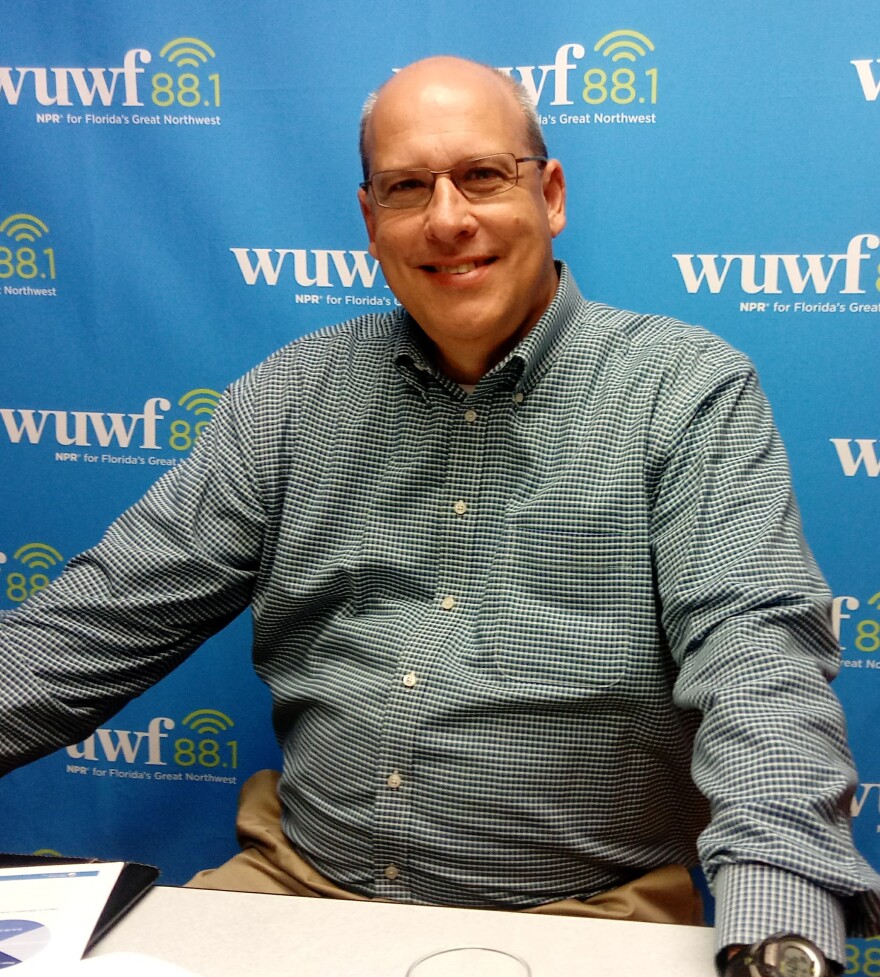Downtown Pensacola will be an even larger beehive of activity on Sept. 21, when the UWF Argonauts play their 2019 football home opener against Virginia-Lynchburg. WUWF’s Dave Dunwoody looks at a new study by the Haas Business Center on the games’ economic impact.
When the Argonauts took the field at Bayfront Stadium for the five home games in 2018, they generated a total of $9.7 million in sales throughout Escambia County, according to Amy Newburn at the Haas Center. The report, she says, contains multiple types of inputs.
“The spending by both the football program and the share of athletics that would be attributed to that,” said Newburn. “Ticket and merchandise sales, concessions, and visitor spending from attendees; day campus and recruitment days as well as the visiting teams that come to the region.”
UWF football’s economic impact was associated with $6.1 million in value added to the economy, supporting 94 jobs and generating approximately $4.6 million in personal income. About 40% of revenues created by the program is associated with visitor spending – that is, outside money.

“They’re spending new money in the region; some of them are staying overnight, but they’re typically making a day of it,” Newburn said. “They’re going to bars and restaurants, they’re going shopping before and after [the games], and so they’re bringing net new money into our region.”
While that $9.7 million figure is countywide, Newburn says the chief beneficiary was downtown Pensacola.
“We do try to understand how much of this spending was happening downtown; and so we asked individuals to estimate how much of their spending in that region,” said Newburn. “We know about $1.2 million in sales is happening in downtown, and then around the football program.”
Argo football has become yet another signature event for downtown Pensacola every fall, according to Todd Thomson — president of the Greater Pensacola Chamber of Commerce.
“Five or six home games; an opportunity to show off our great stadium,” Thomson said. “[An] opportunity to show fans and teams from other parts of the Southeast to see everything that’s happening in our community.”
But UWF is just one of the latest threads of the tapestry that is local sports — joining Blue Wahoos baseball, Ice Flyers hockey, along with myriad other activities. And he says Mother Nature also chips in.
“We have the blessing of a great climate [so] we can schedule events all year,” said Thomson. “Whether it’s tennis tournaments, marathon, half-marathon; it seems like those types of events that seem like at least every month there’s something big happening that brings people from across the country to come and experience Pensacola and Escambia County.”
Another advantage local sports offer, says Thomson, is attracting people who otherwise may not come here.
“I hear it myself, that people are here from an event, and they’ll say, ‘wow, I didn’t realize what has happened in Pensacola — what it’s become with the downtown. I thought it was just the beaches,’” said Thomson. “Now, people — they see the downtown, they see the growth, they see the activity — and they want to come back.”

“We’re in the South; football is a very popular sport in our area; I think people just enjoy going out for Saturday afternoon and watching a football game. It’s been great to have the support we’ve had from the community,” said UWF Athletics Director Dave Scott.
He adds that part of the promotion of the program has involved tourism in general, and downtown Pensacola in particular.
“I think we’ve become a popular spot for when fans are on the road, if they’re looking for a trip to pick they’re looking at Pensacola,” Scott said. “People like coming to Florida, people like coming to our community. So I think part of what bears out in the economic study is people coming in, spending a couple of nights doing things in Pensacola [that] football’s helped bring to the community.”
Instead of just holding its own in competition with other downtown attractions, nightclubs, theaters and art galleries to name a few, Scott believes Argos football and other attractions mutually benefit each other by attracting additional visitors.
“In the economic impact report there was something like 13,000 visitors additionally that come into Pensacola; those are people I don’t think would have normally come and take advantage of other opportunities,” said Scott. “We have many people that come in, maybe go to the festivals, or an art show or a museum and they’re coming over to the game that evening.”
West Florida went 5-6 in their inaugural season in 2016, and reached the Division II championship game the following year. In 2018, the team went 6-5 but missed the playoffs. The Haas Center’s Amy Newburn was asked if the success on the field translates to success at the cash register.

“But you might assume that, as attendance rises or as people really buy into the program and the community feeling, they’re going to want to invite friends from outside the area; [and] purchase more merchandise,” Newburn said. “The overall feeling was that people were very likely to promote UWF football and to recommend it to a friend or family member.”
For the naysayers who lined up against establishing a football program, UWF Athletics Director Dave Scott has a message– offering them a look at the big picture.
“UWF is a great academic institution; we have some great young men and women that represent the university that play 15 different sports,” said Scott. “Football has just created an awareness about the institution and our athletic programs that I don’t think we could have accomplished without adding that sport or making that happen.”
Another report by the Haas Center in 2014 showed that sports and recreation in Florida produced more than $44 billion in total economic output – roughly 3.5% of the Gross State Product. The industry also supported more than 430,000 jobs and $16 billion in labor income.

